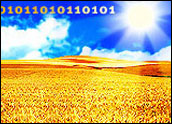
Three solar flares will hit the Earth Thursday and Friday, according to scientists, possibly triggering a bigger show of the Aurora Borealis, also known as the northern lights.
They may also impact the Earth’s magnetic field to some degree, depending on the direction of the magnetic field accompanying them.
The flares have increased the density and velocity of the solar wind, Bernard Jackson of the University of California at San Diego, told TechNewsWorld.
Further, they have led some airlines to reroute some of their so-called great circle flights, which normally go over the North Pole, said Joe Kunches, a space scientist at the National Oceanic and Atmospheric Administration (NOAA)’s space weather prediction center.
Although the flares are the largest seen since 2006, they will be accompanied by only a “minor to moderate magnetic storm at G1 to G2 level,” Kunches told TechNewsWorld.
Pieces of Flare
The sun gave off flares Sunday, Monday and Tuesday, with the largest, an X2.2 flare, released on Tuesday. They were all released from Sunspot 1158, which has expanded rapidly in recent days.
The NOAA’s space weather prediction center expects more M-class flares from the sunspot.
The effects of the flares will be seen Thursday through Saturday, when the space weather prediction center forecasts they’ll die down.
Tuesday’s X2.2 flare is traveling faster than the smaller flares released earlier, and the mass it ejected is expected to catch up with that from the earlier flares, Jackson said.
Still, it’s not as if the mass is racing particularly rapidly. “It’s not moving as fast as ejector from some flares in the past,” Jackson remarked. “It’s going at about 800 kilometers [497 miles] a second, which means it gets to Earth in about two days.”
The ejector mass from Tuesday’s flare is slowing down, Jackson stated. He helped design the Solar Mass Ejection Imager, which has been orbiting the Earth since 2003.
Flaring Out on Earth
The flares may cause outages in shortwave radio high frequency communications, which are used by the military, NOAA’s Kunches said.
Some such outages have already been reported in southern China.
Further, satellites and communications for great circle flights may be impacted.
“Some of the carriers are flying a more southerly route so they have a line of sight to the satellites,” Kunches said. “That gives them the most options for communications as they go about their flight,” he added.
Satellites could be impacted by the plasma included in the ejector, Jackson said. That plasma creates different charge levels in different parts of a satellite it hits, leading to what effectively is a short-circuit between them, Jackson said. This might fry some of the electronics in the satellites.
“In the past, a couple of satellites have died when a large ejection of mass has hit them,” Jackson stated. “One of them was a Japanese spacecraft.”
The bigger issue, however, could be the direction of the magnetic field that was pushed outward from the sun during the flares.
“Depending on its direction, it could couple with the Earth’s magnetic field, which could have a large effect,” Jackson remarked. However, the effect can’t be predicted because “you can’t observe that or even extrapolate it out from the sun very well,” Jackson said.
That magnetic field could change the magnetic field of the Earth. It could also affect global positioning systems.
Not That Big?
While this is “probably the first true geomagnetic storm of this solar cycle,” it’s not a particularly large one, the NOAA’s Kunches said.
Solar flares are classified as A, B, C, M or X in ascending order, according to the peak flux in watts per square meter of 100 to 800 picometer X-rays near earth as measured on the GOES (Geostationary Operational Environmental Satellites) spacecraft.
Each class has a peak flux 10 times greater than the preceding one, and is subdivided into nine sub-classes on a linear basis. That means an X2 flare is twice as powerful as an X1.
X-class flares are large. They can trigger planet-wide radio blackouts and long-lasting radio storms.
Solar flares cause geomagnetic storms here on Earth, and the NOAA has listed five classes of geomagnetic storms, ranging from G1, which is the lowest, to G5.
The geomagnetic storms that will accompany this latest group of solar flares are expected to be in the G1 or G2 range, NOAA’s Kunches said.
G1 geomagnetic storms are minor. They can cause weak power grid fluctuations, may have a minor impact on satellite operations, and make the aurora visible at high latitudes.
G2 storms are moderate. They may cause voltage alarms in power systems at high latitudes, and extended storms may damage transformers. Spacecraft may need course corrections from ground control, and their orbits may be impacted.
Further, high frequency radio communications can fade at higher latitudes with G2 storms.





















































